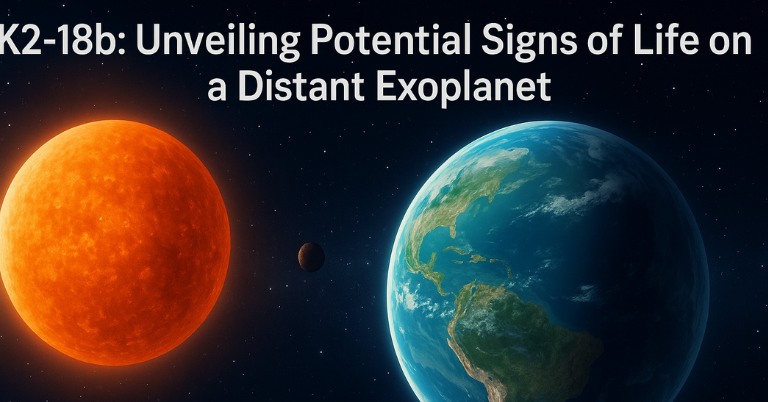The quest to find life beyond Earth has taken a significant leap forward with recent observations of exoplanet K2-18b. Located approximately 124 light-years away in the constellation Leo, K2-18b has become the focus of intense scientific interest due to potential biosignatures detected in its atmosphere. These findings, made possible by the James Webb Space Telescope (JWST), could reshape our understanding of habitable environments in the universe.
Understanding K2-18b
Discovery and Characteristics
K2-18b was discovered in 2015 by NASA’s Kepler Space Telescope using the transit method, which detects dips in a star’s brightness as a planet passes in front of it. This exoplanet is classified as a sub-Neptune, with a radius about 2.6 times that of Earth and a mass approximately 8.6 times greater. It orbits its host star, a red dwarf named K2-18, every 33 days, placing it within the star’s habitable zone where conditions might allow for liquid water.
The Hycean World Hypothesis
K2-18b is considered a candidate for a “Hycean” world—a term combining “hydrogen” and “ocean.” These planets are theorized to have vast oceans beneath hydrogen-rich atmospheres, creating conditions that could support microbial life. The concept of Hycean worlds expands the traditional criteria for habitability, suggesting that life could exist in a broader range of planetary environments than previously thought.
Atmospheric Observations by JWST
The JWST has provided unprecedented insights into the atmospheric composition of K2-18b. Using its Near Infrared Spectrograph (NIRSpec) and Near Infrared Imager and Slitless Spectrograph (NIRISS), the telescope analyzed the starlight filtered through the planet’s atmosphere during transits. This technique revealed the presence of several key molecules:
- Methane (CH₄): Detected at significant levels, methane is a potential indicator of biological activity, though it can also be produced through geological processes.
- Carbon Dioxide (CO₂): The presence of CO₂ supports the possibility of a dynamic atmosphere and potential greenhouse effects that could maintain liquid water.
- Dimethyl Sulfide (DMS): On Earth, DMS is primarily produced by marine microorganisms, making its detection on K2-18b particularly intriguing. However, the identification of DMS is tentative and requires further confirmation.
- These findings suggest that K2-18b possesses a complex atmosphere with components that, on Earth, are associated with life.
Implications for Habitability
Potential for Liquid Water
The combination of atmospheric gases and the planet’s location within the habitable zone implies that K2-18b could host liquid water—a crucial ingredient for life as we know it. The hydrogen-rich atmosphere might create a greenhouse effect, maintaining surface temperatures conducive to sustaining oceans.
Biosignatures and Their Significance
The detection of DMS, albeit tentative, is particularly noteworthy. On Earth, DMS is exclusively produced by biological processes, primarily by phytoplankton in marine environments. If confirmed, its presence on K2-18b could be a strong indicator of biological activity. However, scientists caution that abiotic processes could also produce DMS, and further observations are necessary to rule out non-biological sources.
- Scientific Caution and Future Research
While the findings are promising, the scientific community urges caution. The detection of potential biosignatures like DMS requires rigorous validation to confirm their biological origin. Upcoming observations with JWST and other telescopes will aim to: - Confirm the presence of DMS: Additional data will help determine the reliability of the initial detection and assess its abundance.
- Search for other biosignatures: Identifying additional molecules associated with life could strengthen the case for habitability.
- Understand atmospheric dynamics: Studying the planet’s atmospheric structure and composition will provide insights into its potential to support life.
These efforts will contribute to a more comprehensive understanding of K2-18b’s environment and its suitability for life.
Broader Implications for Exoplanet Research
The study of K2-18b has broader implications for the search for life beyond Earth. It highlights the importance of considering a diverse range of planetary environments, including those that differ significantly from Earth’s. Hycean worlds, with their potential for vast oceans and protective atmospheres, represent a new frontier in astrobiology.
Furthermore, the capabilities of JWST demonstrate the power of advanced telescopes in characterizing exoplanetary atmospheres. As technology continues to advance, our ability to detect and analyze potential biosignatures will improve, bringing us closer to answering the profound question of whether we are alone in the universe.
Conclusion
The observations of K2-18b mark a significant milestone in the search for extraterrestrial life. While the detection of potential biosignatures like DMS is not definitive proof of life, it opens exciting avenues for further research and exploration. As scientists continue to investigate this distant world, K2-18b serves as a compelling reminder of the vast possibilities that exist beyond our solar system.
